The Bloodhound SSC is an extraordinary vehicle. And it couldn't be otherwise, if it weren't for the objective to dethrone the Thrust SSC Ultimate, the holder of the track speed record. What does it take to cross the 1000 miles per hour barrier? In addition to courage and will, 135,000 hp of power also help.
The fastest vehicle status on land currently belongs to the Thrust SSC Ultimate, which with Andy Green at the controls reached 1,227,985 km/h in 1997.SEE ALSO:
strong>A Rolls Royce of the seas that «flying» softlyThe same driver now intends, almost 20 years later, to renew his record. But this time the bar is a little higher, exactly 381,359 km/h higher. In this article we show some of the key points of the engineering work that is the Bloodhound SSC.
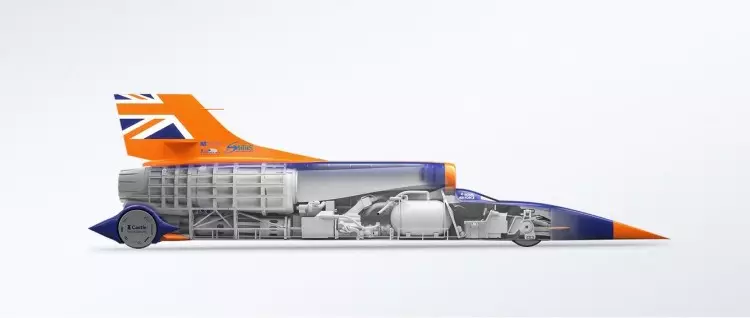
The project was publicly unveiled in October 2008 at the Science Museum in London, and since then the 74-person team led by Richard Noble has been studying, programming and developing the Bloodhound SSC so that between July and September 2015 the current record is shattered in Hakskeen Pan, South Africa.
Engines
In order for the Bloodhound SSC to be able to surpass the 1000 miles per hour barrier, it has two propulsion engines: a hybrid rocket system which we've already written about in detail here, and a jet engine. The latter is a Rolls Royce EJ 200 engine, an engine that contributes in large part to the 135,000 horsepower – and yes, it's well written, it's center and thirty-five thousand horsepower total in this four-wheel sprinter.
these two engines are capable of holding an object weighing almost 22 tonnes in the air or, if you prefer, 27 Smarts ForTwo and a few more powders – my mother-in-law for example. Or yours, if you insist...
Still not impressed? The Rolls Royce EJ 200 jet engine that powers the Eurofighter Typhoon fighter and is capable of sucking in 64,000 liters of air…per second. Convinced? It's good that they are…
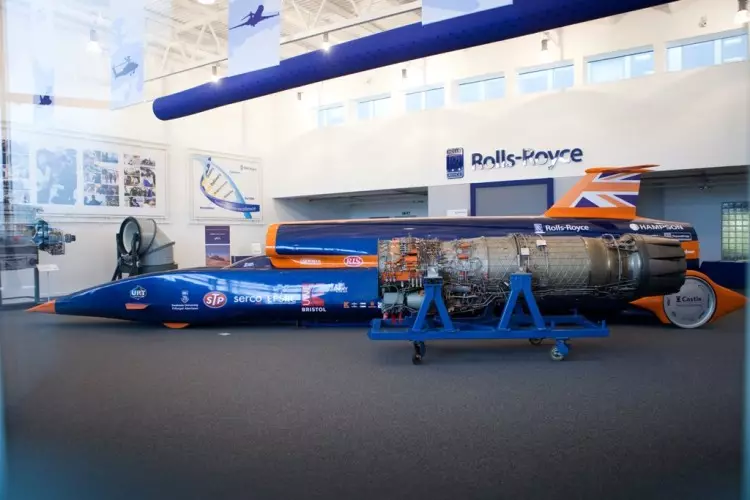
Despite everything, and rigor being a feature that we like, when referring to the output of a jet engine or a rocket, it is technically more correct to speak in kilogram-force instead of horsepower. In the case of the EJ 200 engine it is approximately 9200kgf, whereas in the hybrid rocket it is 12 440kgf.
But what does this represent? In a somewhat abstract and summarized way, it means that together, these two engines placed motionless vertically and running at full power, would be able to hold an object weighing almost 22 tonnes in the air or, if you prefer, 27 Smarts ForTwo and anything else – my mother-in-law for example. Or yours, if you insist...
brakes
In order to stop this real colossus, three different systems will be used. After all engines have been switched off, the friction force is in charge of quickly decelerating the Bloodhound SSC to 1300 km/h, at which point the Air Brake system is activated which will be able to cause a deceleration of 3 G's, courtesy of 9 tons of friction caused by this system. This system is activated progressively in order to maintain a constant deceleration so that Andy Green, the pilot, doesn't lose consciousness. The functioning of this system can be seen in the video:At 965 km/h, the parachute comes into play. The initial impact of the opening is equivalent to 23 tons. There is resistant material! The deceleration will also be in the order of 3 G's.
Finally, at 320 km/h the most mundane disc brakes are activated. It is necessary to add several factors to have a real perception of the mechanical and thermal stress to which the brake discs will be exposed: the Bloodhoud SSC weighs 7 tons, the wheels will be rotating at 10 000 rpm and at 320 km/h it intends to a deceleration of 0.3 g's is achieved with this system. Initially, carbon discs were tested, whose 'remains' prove their inability to deal with the situation. The team then decided to start testing steel discs. The amount of energy to be dissipated is enormous, as can be seen in the most recent video that was made available:
exterior
Taking into account the supersonic capacity of this vehicle, the bodywork is a mix of technologies from the automotive and aeronautics industries: at the front, a carbon fiber “cockpit” technically similar to those used in Formula 1; at the rear, aluminum and titanium are the materials of choice. In total, they are almost 14 meters long, 2.28 meters wide and 3 meters high, measures that once again reveal the sharing of DNA with the aeronautical industry.
The aerodynamic props are also placed on the outside: the rear “fin”, responsible for keeping the Bloodhound SSC in a stable direction, has undergone several modifications since the first designs, as it has some tendency to suffer vibration phenomena, potentially destructive in the predicted speed range – at over 1000km/h this is not good news. Ahead are two more wings responsible for keeping the Bloodhound SSC's nose very close to the ground.
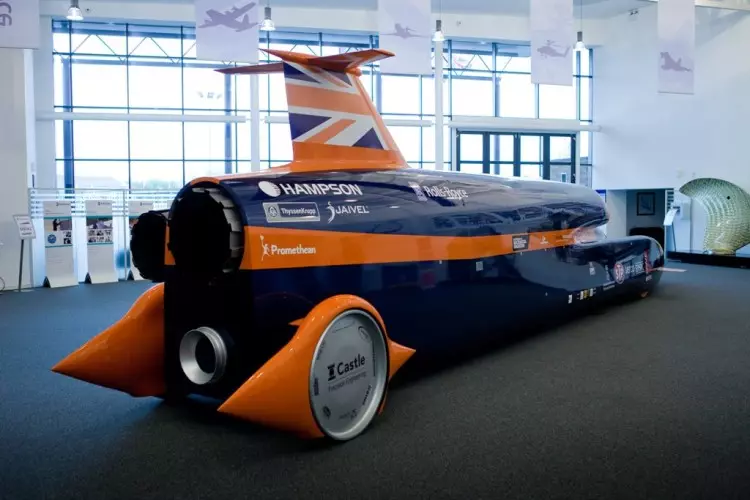
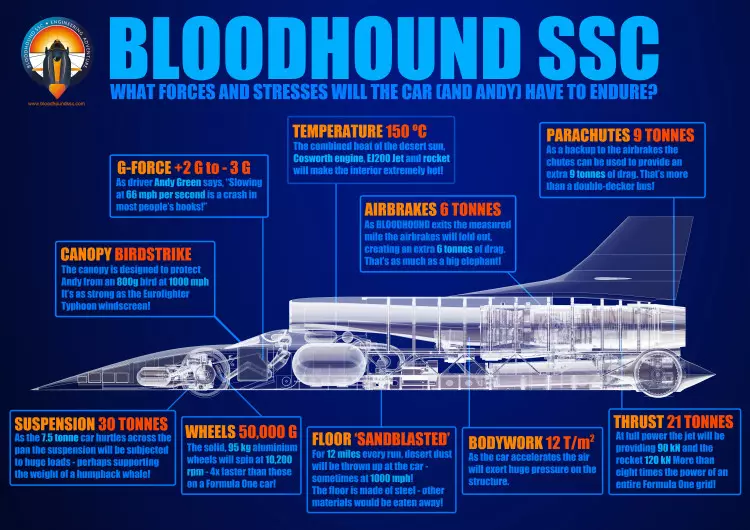
interior
Inside, Andy Green will be using purpose-built bloodhounds for the Bloodhound SSC by Rolex, one of the project's many official sponsors. The speedometer is something worth noting as it is similar to a tachometer, however the “10” does not represent 10,000 engine rpm, but rather the coveted 1000 miles per hour. On the right-hand side will be a 1-hour chronograph, the time limit for reaching the record after starting the attempt. Simple isn't it?
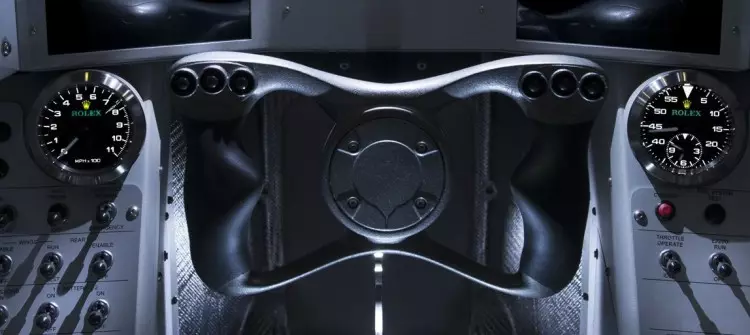
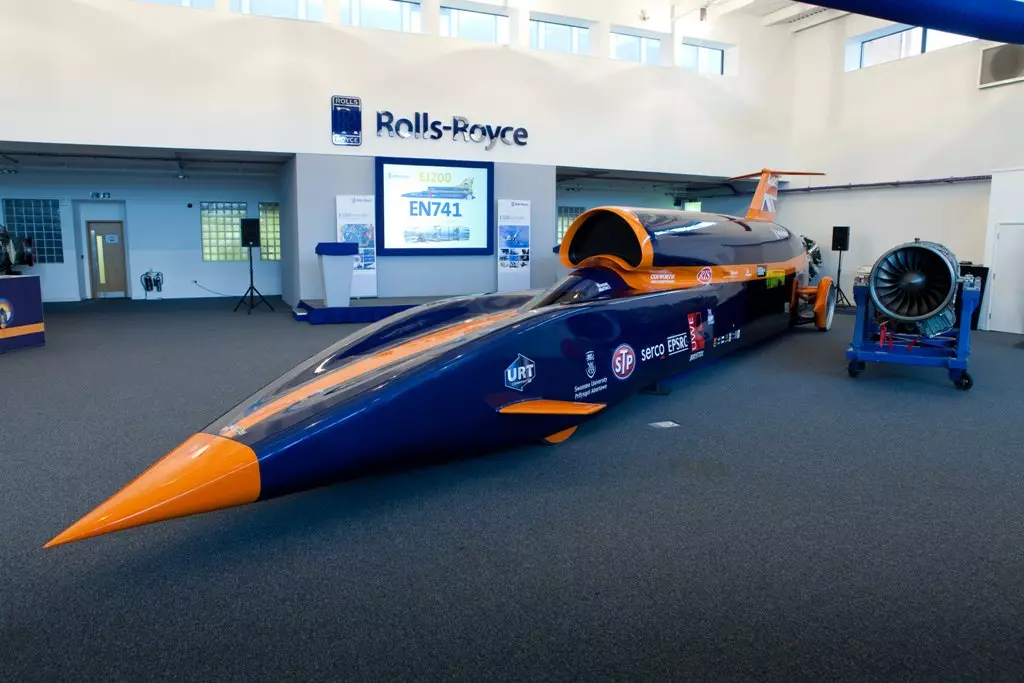
Images and video: bloodhoundssc.com
